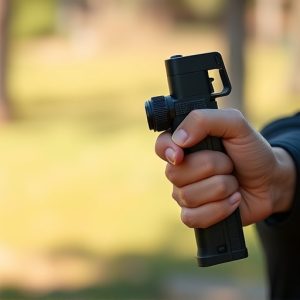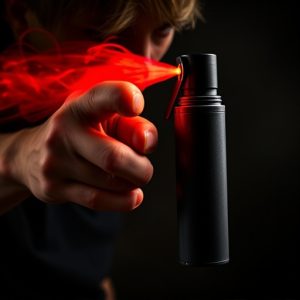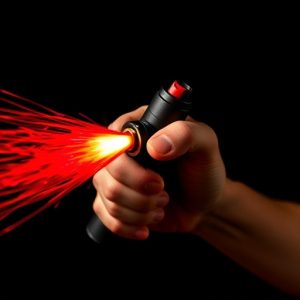Pepper Spray Holster Placement Guide: Optimal Positioning for Quick Access
The Pepper Spray Holster Placement Guide emphasizes strategic positioning for quick and effective ri…….
The Pepper Spray Holster Placement Guide emphasizes strategic positioning for quick and effective riot control. It recommends attaching holsters firmly at waist or thigh level, prioritizing visibility and accessibility over discretion. Lower holsters are ideal for close-quarters combat, while higher ones offer better long-range visibility. The guide considers environmental factors, ease of use, and weather conditions to ensure optimal effectiveness during high-pressure situations, ultimately enhancing de-escalation efforts and safety for law enforcement and riot control personnel.
“Uncover the secrets to effective riot control with our comprehensive guide on pepper spray holster placement. Understanding the optimal positioning of your device is crucial for quick access during high-pressure situations. This article delves into the key considerations for choosing the best location for your pepper spray holster, ensuring efficient deployment.
From factors influencing dispenser placement to best practices for carrying and using these powerful tools, we provide a detailed Pepper Spray Holster Placement Guide.”
- Understanding Pepper Spray Holster Placement: Key Considerations
- Optimal Positioning for Quick and Effective Access
- Factors Influencing the Choice of Pepper Spray Dispenser Location
- Best Practices for Carrying and Using a Riot Control Spray Device
Understanding Pepper Spray Holster Placement: Key Considerations
When it comes to effective riot control, proper Pepper Spray Holster Placement is crucial. A well-positioned holster ensures quick and easy access during high-pressure situations, maximizing its impact as a de-escalation tool. The key considerations involve balance, visibility, and comfort.
For optimal balance, the holster should be attached firmly to the user’s body, typically on the waist or thigh, distributing the weight evenly. Visibility is paramount; the pepper spray should be easily reachable and clearly visible, allowing users to deploy it swiftly without needing to search for their equipment. Comfort is also essential, as officers often need to maintain mobility and stamina during prolonged use. The right holster design accommodates these needs, transforming pepper spray from a cumbersome accessory into an integral part of an officer’s protective gear.
Optimal Positioning for Quick and Effective Access
In the heat of an inflammatory riot, quick and effective access to control spray is paramount. The optimal positioning of a pepper spray dispenser, often secured in a holster, plays a crucial role in this. According to a Pepper Spray Holster Placement Guide, placing the holster on the dominant side allows for easy reach with minimal obstruction. This strategic placement ensures that law enforcement officers or riot control personnel can deploy the spray swiftly and accurately when faced with agitated crowds.
Furthermore, considering the height at which the holster is secured is essential. Lower holsters provide quicker access during close-quarters encounters, while higher positions offer better visibility and control for long-range situations. The guide emphasizes that a well-placed pepper spray holster should be discreet but readily available, enabling users to focus on de-escalation efforts without compromising their safety or effectiveness in riot control scenarios.
Factors Influencing the Choice of Pepper Spray Dispenser Location
When choosing a location for a pepper spray dispenser, several factors come into play, as it’s not just about convenience but also effectiveness and safety. The Pepper Spray Holster Placement Guide recommends considering the environment and target audience. For instance, in high-crime areas or during demonstrations, strategically placing the dispenser on an accessible yet visible spot can deter potential rioters quickly. The choice of location should also account for ease of use; it must be easily operable under stress to ensure officers or individuals can defend themselves promptly.
Furthermore, weather conditions and physical surroundings matter. In outdoor settings, consider protection from elements that could hinder the spray’s effectiveness, such as wind or heavy rain. Indoor spaces may require different placement strategies, considering crowd flow and potential hiding spots for aggressors. A well-thought-out arrangement of these dispensers can significantly contribute to riot control, offering a powerful tool in the hands of those charged with maintaining peace.
Best Practices for Carrying and Using a Riot Control Spray Device
When carrying a riot control spray dispenser, such as a pepper spray device, proper placement in a holster is paramount for quick and efficient access during an emergency. A Pepper Spray Holster Placement Guide recommends positioning the holster close to your dominant hand, ensuring it’s easily reachable yet secure. This strategic location allows for swift deployment when facing a riot or other high-risk situation.
During use, maintain a firm grip on the spray dispenser, aiming for the eyes and face of the intended target. Keep your body between the spray nozzle and bystanders to minimize cross-contamination. Always be mindful of wind direction, using it to your advantage while ensuring you don’t inadvertently spray yourself or innocent people nearby. Regular practice in safe environments helps refine these skills, making you more prepared for real-world scenarios.
In conclusion, this Pepper Spray Holster Placement Guide has highlighted the critical aspects of optimal positioning for quick access during inflammatory riot control situations. Understanding the factors influencing dispenser location and adhering to best practices for carrying and using these devices is essential for effective law enforcement and public safety. By implementing the key considerations discussed here, officers can ensure they are prepared and equipped to handle challenging scenarios with speed and efficiency.


